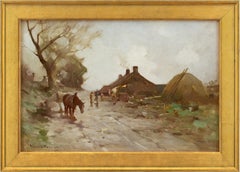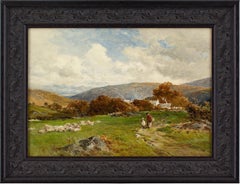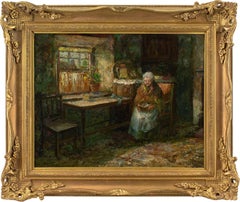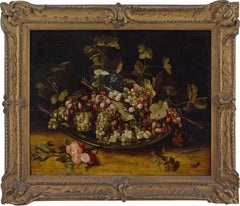Want more images or videos?
Request additional images or videos from the seller
1 of 13
Auction endedBrowse Current Auctions
Unknown20th-Century British School, Composition With Man Reading, Oil Paintingc. 1960
c. 1960
Price:$864.53
$2,031.45List Price
About the Item
- Creation Year:c. 1960
- Dimensions:Height: 26 in (66.04 cm)Width: 30.5 in (77.47 cm)
- Medium:
- Movement & Style:
- Period:
- Condition:Artwork presents well. Frame with some light wear.
- Gallery Location:Cheltenham, GB
- Reference Number:1stDibs: LU2328211800372
About the Seller
5.0
Platinum Seller
Premium sellers with a 4.7+ rating and 24-hour response times
Established in 2017
1stDibs seller since 2023
247 sales on 1stDibs
Typical response time: 3 hours
Authenticity Guarantee
In the unlikely event there’s an issue with an item’s authenticity, contact us within 1 year for a full refund. DetailsMoney-Back Guarantee
If your item is not as described, is damaged in transit, or does not arrive, contact us within 7 days for a full refund. Details24-Hour Cancellation
You have a 24-hour grace period in which to reconsider your purchase, with no questions asked.Vetted Professional Sellers
Our world-class sellers must adhere to strict standards for service and quality, maintaining the integrity of our listings.Price-Match Guarantee
If you find that a seller listed the same item for a lower price elsewhere, we’ll match it.Trusted Global Delivery
Our best-in-class carrier network provides specialized shipping options worldwide, including custom delivery.You May Also Like
Large Geometric Abstract Mixed Media Titled Africana
Located in Lake Worth Beach, FL
Africana
Mid-Century Modern large and impressive mixed media, sand and oil on artist board. The painting is unsigned there is a small fragment of old paper label with number #21 titl...
Category
1960s Abstract Geometric Abstract Paintings
Materials
Sandstone
$4,000 Sale Price
20% Off
H 50 in W 100 in D 1.5 in
1950s Original Geometric Abstract Oil Painting, Vertical & Horizontal Art
By Paul Kauvar Smith
Located in Denver, CO
This vibrant and dynamic original abstract oil painting by Paul Kauvar Smith (1893–1977) showcases the artist’s bold use of color and modernist technique. Executed in oil on board, t...
Category
1950s Abstract Geometric Abstract Paintings
Materials
Oil, Board
$2,450
H 29.5 in W 23.75 in D 2 in
1970 British oil on floating panel work by Patrick Hughes, pink on white
By Patrick Hughes
Located in Petworth, West Sussex
Patrick Hughes (British, b.1939)
Assemblage, c. 1970
Oil on floating panel
35.7/8 x 47.7/8 in. (90.8 x 121.3 cm.)
Patrick Hughes is a British artist known as the creator of reverspe...
Category
Mid-20th Century Abstract Geometric Abstract Paintings
Materials
Oil, Board
$5,163
H 35.88 in W 47.88 in D 3 in
Jean POUGNY born Iwan Albertovich PUNI (1890–1956), "The Ace of Clubs"
By Jean Pougny
Located in Paris, FR
Iwan Albertovich Puni (also known as Jean Pougny) was a Russian avant-garde artist (Suprematism, Cubo-Futurism) who later became French. He evolved towards Lyric Primitivism, influen...
Category
1910s Abstract Geometric Abstract Paintings
Materials
Oil, Cardboard
$35,581
H 11.42 in W 7.88 in
Solo II 2005., Cardboard, author's technique, 64x45 cm
Located in Riga, LV
Solo II
Uldis Krauze (1958)
2005., Cardboard, author's technique, 64x45 cm
Category
Early 2000s Abstract Geometric Figurative Paintings
Materials
Oil, Cardboard
$436 Sale Price
20% Off
H 25.2 in W 17.72 in D 0.04 in
Green Colorful Abstract Mixed Media Painting: Triciclo
By Juan Lazaro Gutierrez
Located in New York, NY
Born in Manuel, Cuba in 1973, Juan Lazaro Gutierrez Mamblas is a painter who focuses his vision on the bicycle. His abstract works with forms floating on a virtually monochrome groun...
Category
2010s Abstract Geometric Mixed Media
Materials
Oil, Acrylic, Cardboard, Ballpoint Pen
$680
H 13.5 in W 9.5 in
Mid Century Modern Vintage Swedish Abstract Cityscape Oil Painting -Urban Blocks
Located in Bristol, GB
URBAN BLOCKS
Size: 48 x 63.5 cm (including frame)
Oil on board
A striking mid-century abstract cityscape rendered in a restrained muted palette, executed in oil onto board.
The pai...
Category
Mid-20th Century Abstract Geometric Abstract Paintings
Materials
Oil, Board
$1,343
H 18.9 in W 25.01 in
"Untitled, " Seymour Fogel, Geometric Abstraction, Texas Hard-Edge
By Seymour Fogel
Located in New York, NY
Seymour Fogel
Untitled
Oil on illustration board construction
10 x 7 1/2 inches
Provenance:
Estate of the artist
Charles and Faith McCracken
Larry and Trish Heichel
Private Collection
Seymour Fogel was born in New York City on August 24, 1911. He studied at the Art Students League and at the National Academy of Design under George Bridgeman and Leon Kroll. When his formal studies were concluded in the early 1930s he served as an assistant to Diego Rivera who was then at work on his controversial Rockefeller Center mural. It was from Rivera that he learned the art of mural painting.
Fogel was awarded several mural commissions during the 1930s by both the Works Progress Administration (WPA) and the Treasury Section of Fine Arts, among them his earliest murals at the Abraham Lincoln High School in Brooklyn, New York in 1936, a mural in the WPA Building at the 1939-1940 New York World's Fair, a highly controversial mural at the U.S. Post Office in Safford, Arizona (due to his focus on Apache culture) in 1941 and two murals in what was then the Social Security Building in Washington, D.C., also in 1941. Fogel's artistic circle at this time included Phillip Guston, Ben Shahn, Franz Kline, Rockwell Kent and Willem de Kooning.
In 1946 Fogel accepted a teaching position at the University of Texas at Austin and became one of the founding artists of the Texas Modernist Movement. At this time he began to devote himself solely to abstract, non-representational art and executed what many consider to be the very first abstract mural in the State of Texas at the American National Bank in Austin in 1953. He pioneered the use of Ethyl Silicate as a mural medium. Other murals and public works of art done during this time (the late 1940s and 1950s) include the Baptist Student Center at the University of Texas (1949), the Petroleum Club in Houston (1951) and the First Christian Church, also in Houston (1956), whose innovative use of stained glass panels incorporated into the mural won Fogel a Silver Medal from the Architectural League of New York in 1958.
Fogel relocated to the Connecticut-New York area in 1959. He continued the Abstract Expressionism he had begun exploring in Texas, and began experimenting with various texturing media for his paintings, the most enduring of which was sand. In 1966 he was awarded a mural at the U.S. Federal Building in Fort Worth, Texas. The work, entitled "The Challenge of Space", was a milestone in his artistic career and ushered in what has been termed the Transcendental/Atavistic period of his art, a style he pursued up to his death in 1984. Painted and raw wood sculpture...
Category
Mid-20th Century Abstract Geometric Abstract Paintings
Materials
Oil, Board
$4,600 Sale Price
20% Off
H 16 in W 13.5 in
Street Life. Contemporary Abstract Figurative Oil Painting
By Christopher Barrow
Located in Brecon, Powys
An abstract walk in town from the studio of Christopher Barrow
Oil on board. Signed. Image 20" x 16". Framed 23" x 19"
Category
2010s Abstract Geometric Abstract Paintings
Materials
Oil, Board
$1,087
H 19 in W 23 in
"The Group" Figurative Geometric Abstract Oil Painting
By Christopher Barrow
Located in Brecon, Powys
Geometric figurative abstraction
Oil on board
Well framed and signed
Category
2010s Abstract Geometric Figurative Paintings
Materials
Oil, Board
More From This Seller
View AllRobert Russell MacNee, Landscape With Farm, Track & Horses
By Robert Russell Macnee
Located in Cheltenham, GB
This evocative early 20th-century oil painting by Scottish artist Robert Russell MacNee RGI (1880-1952) depicts a farm with a track, horses, and figures. MacNee was an accomplished p...
Category
1910s Landscape Paintings
Materials
Oil, Board
David Bates, Behind The Village, Capel Curig
By David Bates b.1840
Located in Cheltenham, GB
This early 20th-century oil painting by British artist David Bates (1840-1921) depicts a rural view in Capel Curig, North Wales. Bates was an accomplished landscape painter who often...
Category
Early 1900s Victorian Landscape Paintings
Materials
Canvas, Oil, Board
John Falconar Slater, Interior With Woman Reading
By John Falconar Slater
Located in Cheltenham, GB
This early 20th-century oil painting by English artist John Falconar Slater (1857-1937) depicts a rustic cottage interior with an elderly lady reading. Slater was an accomplished, Ro...
Category
1910s Figurative Paintings
Materials
Oil, Board
Mid-17th-Century Flemish School, Still Life With Grapes & Foliage On A Plate
Located in Cheltenham, GB
This exquisite mid-17th-century Flemish oil painting depicts a still life with an abundance of fruit and flora perched atop a pewter plate. It’s a decadent array of nature’s finest. ...
Category
17th Century Flemish School Still-life Paintings
Materials
Oil, Panel
Giuseppe Pesci (Attributed), Still Life With Flowers, Vase & Peacock
By Giuseppe Pesci
Located in Cheltenham, GB
This early 18th-century oil painting, attributed to Italian artist Giuseppe Pesci (d. 1722), depicts a peacock alongside radiant blooms in a vase. Pesci is known predominantly for hi...
Category
Early 18th Century Italian School Still-life Paintings
Materials
Canvas, Oil
Early 19th-Century English School Portrait Of Samuel Jones Of Skeyton, Norfolk
Located in Cheltenham, GB
This fine early 19th-century English oil painting depicts Samuel Jones of Skeyton, Norfolk, smartly attired in a black coat with white cravat. The portrait was previously in the coll...
Category
1830s Portrait Paintings
Materials
Canvas, Oil
Recently Viewed
View AllMore Ways To Browse
Man Reading Painting
Boxing Art
Triptych Oil Painting
Chanel Paintings
Painting Exotic
Used Oil Paint Brushes
Portland Maine
Black Background Paintings
Heavy Textured Painting
Katherine Gray
La Licorne
Large Geometric Paintings
Monochrome Abstract Painting
Avant Garde Painting
Benjamin Gray
Julia Gray
Aqua Painting
Black And White Diptych Abstract Painting



